Let’s be real: the color palette of a dog coat is the first thing that we take into consideration when choosing a pup to buy or adopt.
With that being said, general appearance is one of the key factors that breeders use to decide the price of the dog.
Even if you are not a stickler for rules for the coat color scheme, you must be curious about what colors are possible in the dog breed of your interest.
Regardless of what type of dog aficionado you are, you came here to find out about Boerboel colors, so let’s start with the AKC recognized ones:
Acceptable Recognized Colors Of A South African Boerboel
American Kennel Club (AKC) is a registry of purebred dog pedigrees in the United States. This is a regulatory organization whose purpose is to make sure that breeders produce puppies that are going to be healthy and genetically right for future owners.
AKC and the American Boerboel Club (ABC) recognize six acceptable colors in a South African Boerboel breed.
Not only do these hues make Boerboels pretty, but they are also a sign that a dog is going to be free from serious faults caused by genetic mutations that could happen in unethical breeding methods.
These are the AKC accepted colors within the Boerboel breed standards:
• Cream
• Red
• Brown
• Reddish Brown
• Tawny
• Brindle
The Most Common Boerboel Colors
As I said before, coat color is one of the crucial elements that determine the price of a dog.
Taking this information into account, it is logical to assume that dogs with rare color palettes are going to be exponentially more expensive than color schemes that can be seen often.
So, let’s get down to business! These are the most common colors that you will see in a Boerboel breed:
1. Black Boerboel
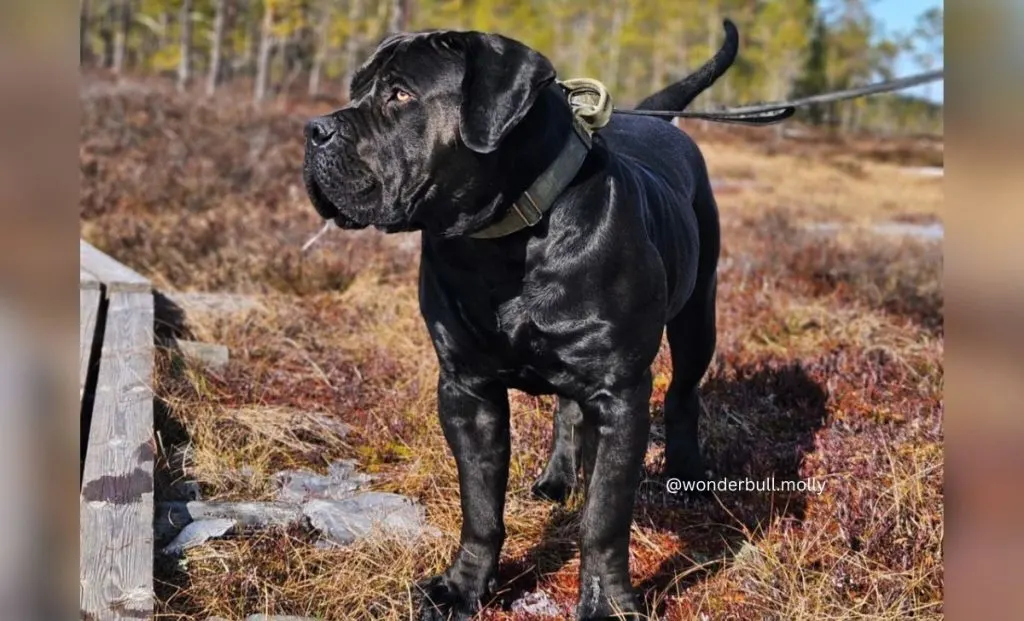
We all love the black color of dogs, am I right?
Black shiny fur makes dogs look like they have a strong and elegant suit at all times. Of course, some people will have a different view on this matter, considering the black color on dogs somewhat scary or, better said, intimidating.
There are many other dog breeds that are viewed as intimidating due to their black coats and sturdy looks, such as Cane Corsos and Doberman Pinschers.
Boerboel is a large animal bred as a working dog for traditional work, so black colors suit him perfectly in a way that many other breeds can only dream of.
Whether you see him as strong and elegant or maybe dominant and intimidating, we can all agree that this is one handsome fellow.
Even with his impressive height and stance, his black-as-night coat serves him well as a guard dog at night, blinding into the darkness. When the sun comes out, black hair has advantages again because they are less susceptible to getting sunburns.
There are some doubts in the dog community that Boerboels with black coats are not to be considered purebred dogs. Professional breeders don’t agree with this as they think of them as a classic basic breed that can be purebred dogs with pedigree just like other breeds.
2. Brindle Boerboel
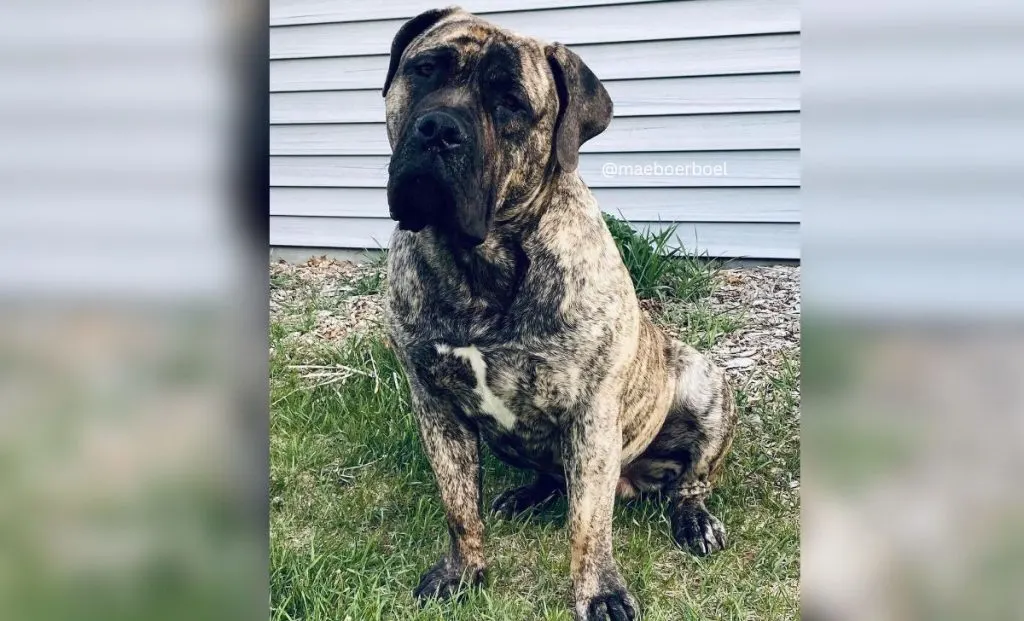
What color is the brindle Boerboel? That question is a little bit more complex than you would normally expect. The brindle color pattern is made of irregular vertical spots or, better said, black lines overlaid over a brown (red/tan) or fawn base color coat.
Such coat color is common in big breeds like the Anatolian Shepherds, Great Danes, and Boxers.
Also, reverse brindles are possible.
This color pattern is also known as ultra-brindle, and it can be observed as some of the base colors in regular brindles (sable/red/brown) being overlaid on a black or generally dark base coat.
They are generally seen as black Boerboels with tan or fawn patterns, depending on the individual. Reverse brindle is often seen in Bull Terriers and Pit Bulls.
The general rule is that Boerboel brindles lean more toward the “dark side” even though lighter brindles also exist.
Not many brindle Boerboels go to dog shows, but they would have every right to do so because they are approved by the American Kennel Club and American Boerboel Club.
Even though they are rare, certified Boerboel breeders will be happy to help you find your brindle puppy if they don’t have it in their kennel.
3. Brown Boerboel
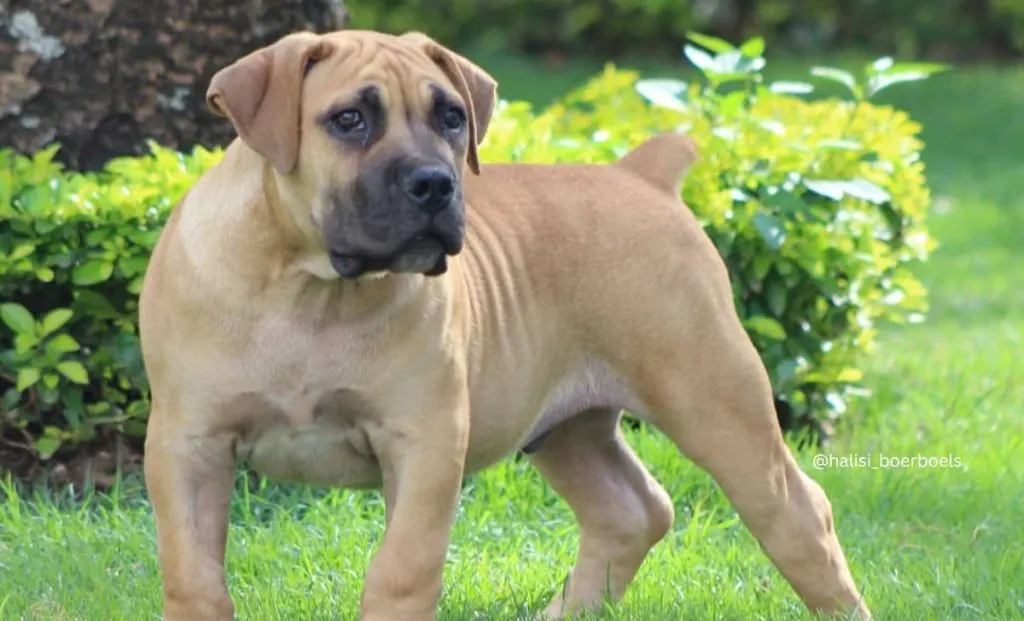
This color is a general standard when it comes to Boerboel and definitely the most widespread of all on this list.
You will most often see a light brown or even a brown with a little bit of orange in most breeder kennels. It is not as dark brown as the one we see in brown Labrador Retrievers.
These dogs often sport a black mask that spreads from their black noses and across their muzzle.
This is the most common type of Boerboel in breeders’ kennels, so don’t worry about not finding your favorite brown puppy.
Considering their impressive demeanor, it is no wonder that this is the most popular color on the market.
4. Red Boerboel
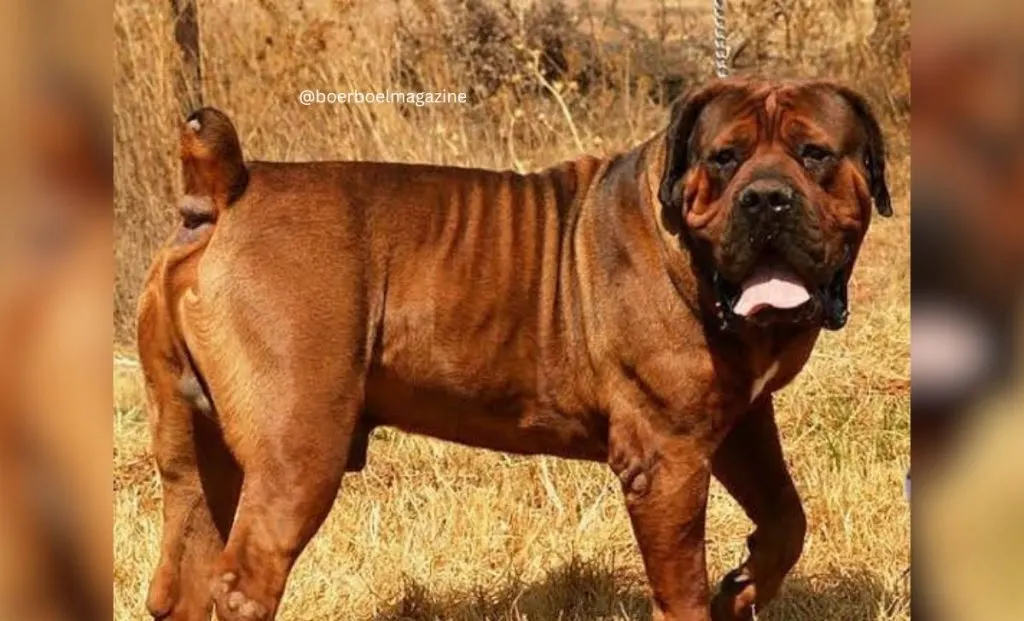
This color really looks magnificent on a Boerboel pup. It’s understandable why the AKC recognizes this color, given the grace and captivating appearance it lends to these dogs, making them stand out as favorites in judging competitions and other dog sports.
Considering the beauty that Boerboels of this color possess, a higher price is likely to be expected.
There are two versions of Red Boerboels. More often, the Boerboels can be found in dark mahogany color, but there are also light chestnut red shades of Boerboels.
There are also some character facts that this color comes with.
These adorable bundles of joy are so affectionate and loving that it’s easy for people to overlook their formidable capabilities as guardians. With their strong protective instincts, they excel in their first line of defense and guarding duties.
That is why reputable breeders must socialize their pups with other people, especially strangers, from a young age — unless they’re specifically trained to guard clients’ needs.
They are wary of strangers and can be hostile if they don’t recognize the particular person who is on their premises, but overall, they are perfect family dogs.
Markings On The Boerboels Fur
Now that we have learned about Boerboel colors, it is time to talk about their markings. These are not structural deviations but marking details that can often appear on their coat. Let’s see all the marking types below:
• White markings
• Piebald
• Irish markings
• Black mask
1. White Markings
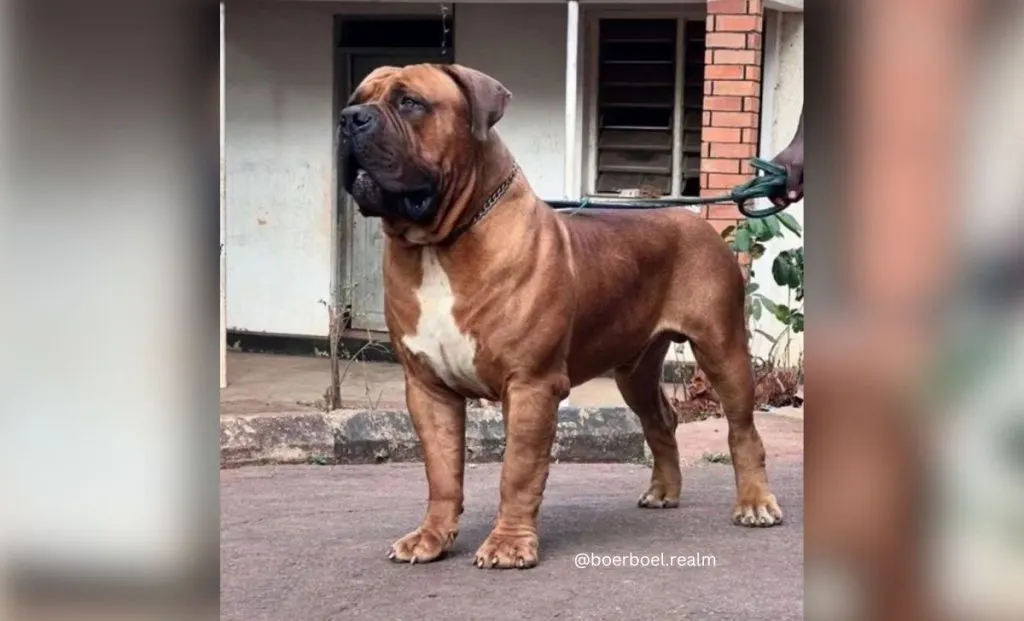
Boerboels can have white markings just like other dog breeds like American Bully, Border Collie, and Bernese Mountain Dogs.
Now, where do these white markings appear on Boerboel’s body?
When it comes to white markings, there really isn’t a rule on where they can appear. They can be found on the nose leather, upper thighs, lower jaw, front legs or back legs, paws, and so on.
Even though these white markings are recognized on the AKC list, for the competition rules, it is important that markings do not occupy more than a third of the Boerboel’s fur.
2. Piebald
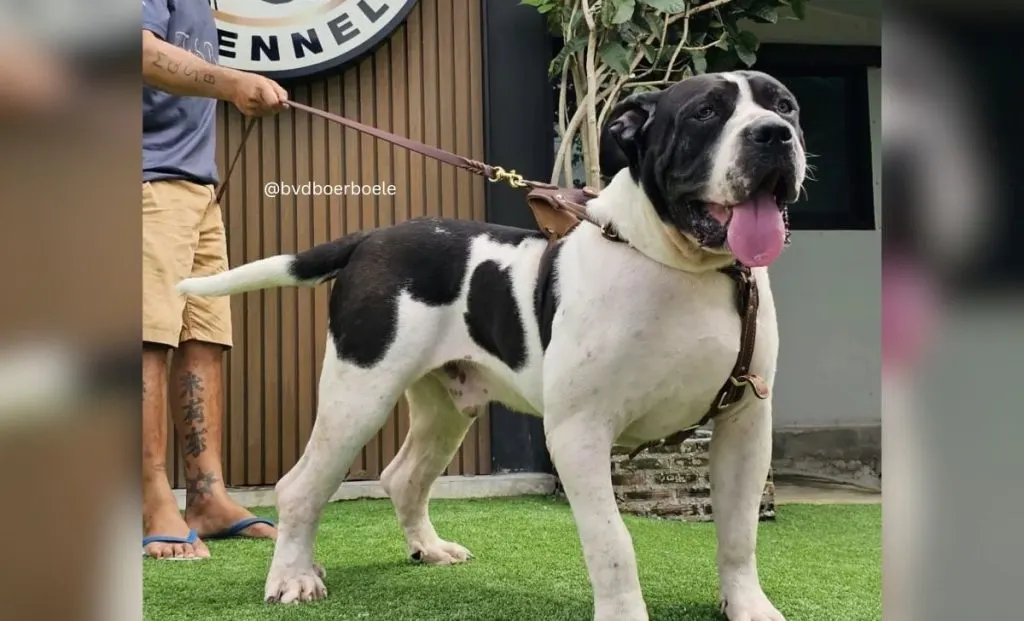
Piebald markings, in the most basic definition, can be white markings on a brown, fawn, or brindle dog. But this can get a little bit tricky in the competition aspect of aesthetics.
These markings on the fur are AKC-certified, but only a couple of pattern varieties are considered desirable. Boerboel with these types of markings will, more often than not, have brown or brindle coat color, with a couple of white markings.
In competition, this is not ideal, and if the dog’s paws are white, it can be an instant disqualification. This might seem weird, but visually, darker paws are considered less sensitive to UV rays, so there is less chance that your beloved Boerboel will get sunburn damage from it.
But let’s be real: competitions look at specific parts and characteristics of your dog, such as exact proportions, teeth, ideal height, strong bone structure, and total length of the head.
These things do not matter in terms of the welfare of the dog, so if you just want a family dog, all of these rules are not important.
Apart from Boerboels, piebald markings are common in smaller breeds like Dachshunds and Pomeranians.
3. Irish Markings
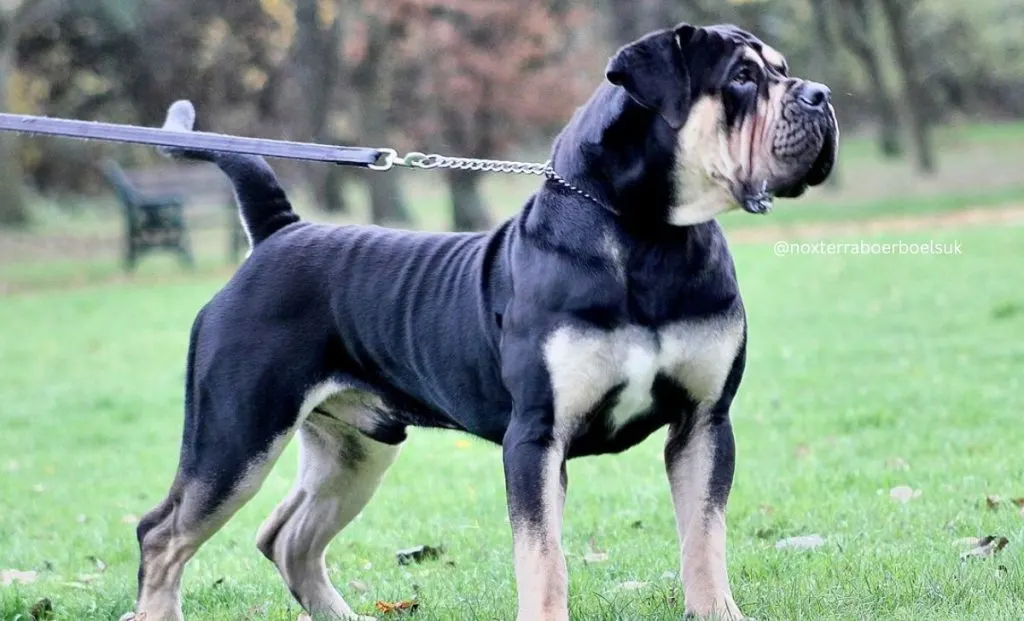
Irish markings are another interesting marking appearing on this list. Similarly to Piebald Boerboels, these Boerboels with Irish markings can be found in a range of color patterns.
Irish markings can come in black, tan, and white forms.
Even though brown and red Boerboels are more desirable on the market, these Irish markings can come in interesting artistic patterns that some people will certainly appreciate.
The reason for the greater demand for brown or red colors is the homogenous color, which means these dogs have prettier pigmentation.
The most common are brown, red, fawn, or brindle Boerboel, which can have white markings on the belly, collar, and feet.
4. Black Mask
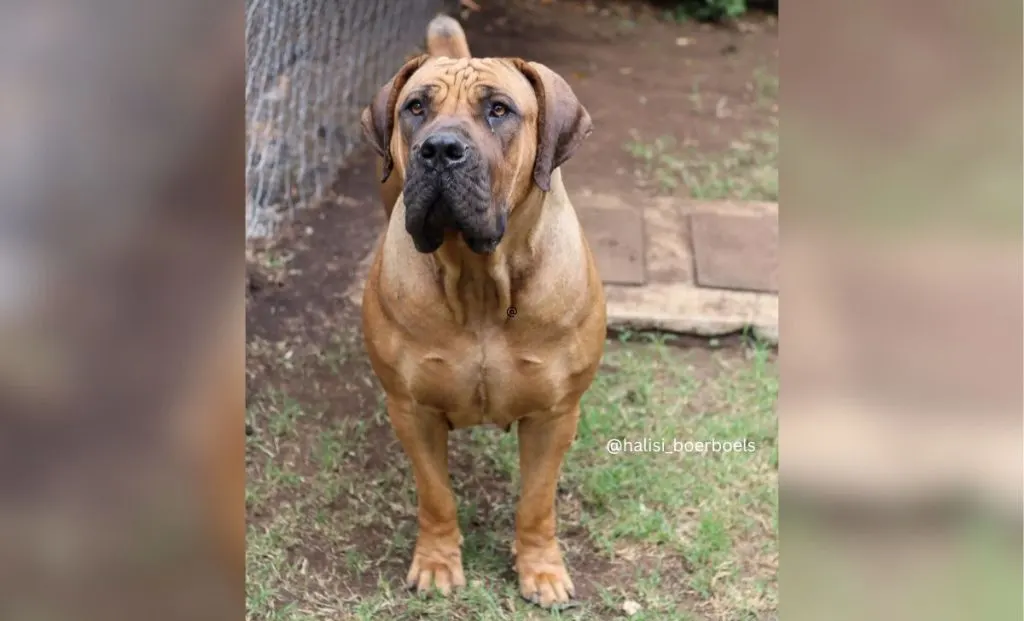
You can understand what a black mask is basically from the name. This pattern can be seen on the dog’s face; by that, I mean the muzzle, the ears, or the entire face of a dog in some individuals.
In regular colors without markings, you would expect all these parts to be the same color as the rest of the dog’s coat. However, with a black mask, the dog looks like a combination of black Boerboel with red or brown Boerboels.
This pattern is not exclusive to Boerboel because there are few other dog breeds where this can be observed, such as the Greyhound, the Pug, the Akita, and the German Shepherd.
Also, the mask has a few variations. They can be full, partial, and extreme, where the black pattern extends past the head to the belly, and, in some cases, the color goes to the toes.
While Piebald and Irish markings are not that sought after, black masks are popular even though they’re somewhat rare. The more the black color spreads, the more the dog will be appreciated.
Appreciation is easy to explain because it not only has aesthetic value but also a pragmatic function. The pragmatic part is the fact that black color will protect Boerboel’s head from the harmful UV rays from the sunlight.
But all this comes at a price.
Dog shows do not accept Boerboels with black masks for competitions because the mix of colors is not acceptable and is up to the rules of the competitions.
Which Colors Are Not Considered Acceptable In A Boerboel breed?
So, after all of these colors and markings that are American Kennel Club certified, sought after, and recognized come unacceptable colors and color pattern markings.
They are defined as follows:
• Blue Boerboel
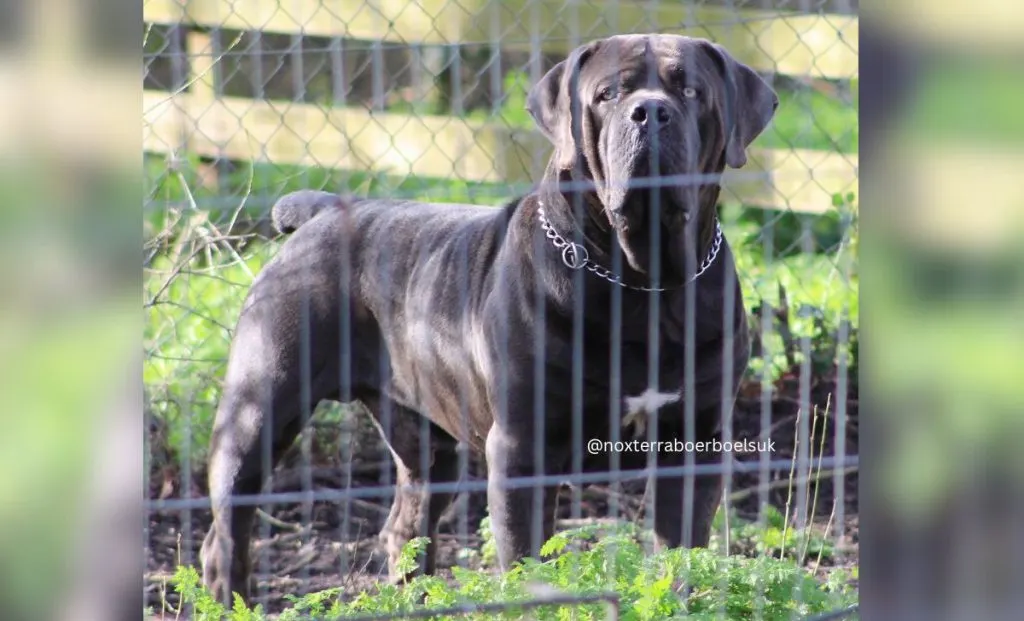
Blue-colored and diluted, better known as powder coat Boerboels, are not accepted by the United Kennel Club and the South African Boerboel Breeder’s Society.
• Black Boerboel without any brindle markings
• Black Boerboel with white markings
Boerboels that display white spots on parts of their body, such as paws, neck, and face, are not deemed acceptable by the United Kennel Club and the South African Boerboel Breeders Society.
• Boerboel with more than 30% of white markings on its body
As I mentioned on this list above, if the white markings extend to over a third of the dog’s coat, it is considered unacceptable by the AKC, United Kennel Club, and the South African Boerboel Breeders Society.
The Boerboel’s Coat
So, in the end, are we really supposed to take into consideration what color our desired puppy’s coat is and if it is considered acceptable by the official clubs, organizations, and competitions?
This depends on what you want to do with your puppy and what kind of job or purpose you are going to give to your dog.
If you decide to enter your dog in competitions, then you will have to meet the regulations and rules of official organizations such as AKC, United Kennel Club, and the South African Boerboel Breeders Society.
Outside of these competitions, the color of the coat is just an aesthetic choice, and it does not influence the dog’s health (except albino dogs) or character in any major way.
The most important characteristic of the Boerboels coat that I need to mention is, first of all, the length of its hair. Boerboel does not have a long coat. In fact, it is always short and packed densely and thickly.
But this doesn’t mean that Boerboel doesn’t need any brushing. Since many people suffer from allergies to dogs’ hair, it is important to brush their coats often to reduce shedding in the house and, most important of all, to keep dogs healthy.
When it comes to bathing, this is not going to be needed often, only if the dog starts smelling bad from all of its physical activities and sweat.
Speaking of activities, Boerboel is going to need it a lot. This is not an indoor dog traditionally, but a working dog that will need a lot of physical activity.
Nail trimmings and ear cleaning are going to have to be done regularly since they tend to get into dirty situations during physical activities and play.

Meet Iram, a devoted veterinarian, passionate dog lover, and current Ph.D. candidate at Utrecht University in the Netherlands. Seamlessly blending her roles as a vet and content writer, Iram channels her love for dogs into heartfelt narratives.
Since childhood, Iram nurtured a dream of becoming a vet, a passion that runs deep in her family. Having now fulfilled that dream, she’s eager to share her acquired knowledge. In her writing, Iram not only explores the emotional bond between humans and their canine friends but also integrates her veterinary expertise, offering readers a holistic understanding of their beloved pets.
